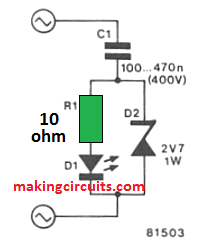This LED circuit can be used to indicate the presence of 220 V mains AC supply, without using a transformer.
The long life of LEDs make them extremely appropriate for on/off indicators.
On the other hand, their use on mains voltages has been constrained considering that a low functioning voltage avoids their direct connection with the mains supply in terms of a neon.

Thankfully, there exists a method with this issue, the AC resistance of a capacitor enables you to limit the current.
No power is lost in the capacitor by any means, considering that the current passing through the capacitor and the voltage around it are 90° out of phase with regard to one another.
Zener diode D2, performing as an normal forward biased diode in this situation, stops excessive voltage levels appearing over the LED throughout the negative half-cycle of the mains waveform.
If this 220 V mains LED indicator circuit is switched on in the positive half, D2 stop the voltage across LED Dl and Rl from rising over 2.7 V.
If an ordinary diode were utilized at this point, as in the earlier circuit, the LED will probably proceed to the big scrap box in the sky.
The importance of CI can help determine the current passing
Leave a Reply